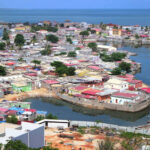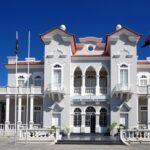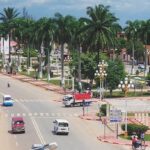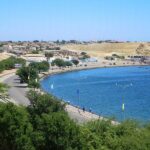Huambo
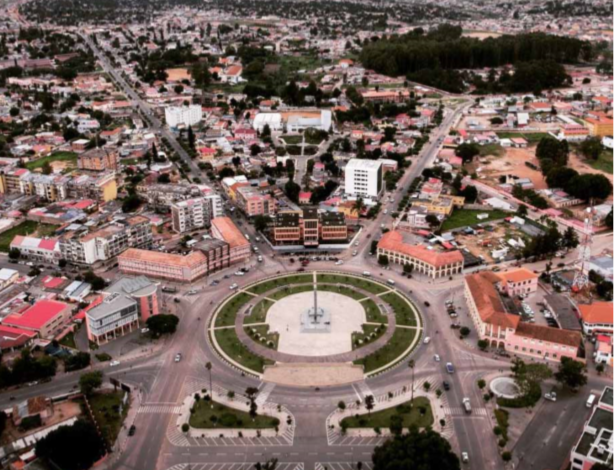
Nestled in the heart of Angola, Huambo, formerly known as Nova Lisboa, is a city that beautifully blends history, culture, and natural beauty. This article takes you on a journey through this remarkable city, the third-most populous in Angola, after Luanda and Lubango.
Early History
Huambo’s name has its roots in Wambu, one of the 14 ancient Ovimbundu kingdoms of the Angolan plateau. These kingdoms date back to the 15th century when the Ovimbundu, originally from Eastern Africa, established their central kingdom of Bailundu. Wambu, although smaller than Bailundu, enjoyed a degree of independence.
It wasn’t until the construction of the Benguela Railway by the Portuguese that Wambu gained recognition. The railway, designed by the British entrepreneur Sir Robert Williams, aimed to connect the rich copper mines of Katanga in Belgian Congo to the coastal town of Lobito. Huambo played a pivotal role due to its favorable climate and abundant water resources.
By 1929, Huambo had become the site of the most important railway workshop in Africa, serving as a hub for trade and transportation.
Prosperous Years Under Portuguese Rule
In 1928, Huambo was renamed Nova Lisboa, reflecting the colonial administration’s intentions of making it the capital of the colony. The city prospered under Portuguese rule, boasting important food processing plants, educational institutions, and significant agricultural wealth.
In the late 1960s, Nova Lisboa gained international recognition for its International Nova Lisboa 6 Hours sports car race. It grew to become one of the most important urban centers in Portuguese Angola.
Post-Independence Challenges
Independence from Portugal in 1975 marked a turning point for the city. The Angolan Civil War, which lasted until 2002, disrupted Huambo’s development, causing extensive damage and significant civilian casualties.
The city’s control shifted between the MPLA and UNITA, with the MPLA eventually regaining control in 1976 with the help of Cuban troops. UNITA’s presence remained, causing tension and violence.
The conflict led to massive population displacements, with civilians seeking refuge in Huambo and nearby towns. The International Committee of the Red Cross arrived in 1979 to provide humanitarian assistance.
Towards Peace and Reconstruction
A peace agreement was reached in 1991, leading to the gradual withdrawal of UN agencies and NGOs. General elections were held in 1992 but sparked unrest, and foreign aid agencies withdrew from Huambo.
Violent clashes persisted, and by late 1992, UNITA had gained control of the city. The armed conflict continued until 1994 when the Lusaka Protocol was signed. Although this marked a step towards normalcy, it raised concerns as UNITA relocated its headquarters to Bailundo.
By 1995, free transit of people and goods was reestablished in the province, and the United Nations peacekeepers were deployed. However, progress was slow, and commercial activities remained subdued.
Challenges in the 21st Century
The early 2000s brought new challenges as international sanctions tightened around UNITA, leading to frequent and destructive military actions in Huambo. In 2001, the government launched a renewed offensive against UNITA, resulting in population displacements and resource pressures.
The death of Jonas Savimbi in 2002 and the signing of a new cease-fire brought tranquility to Huambo and initiated an era of development and reconstruction.
Geography and Climate
Huambo is situated in the central highlands of Angola, near the headwaters of the Cunene River. Its elevation of 1,721 meters gives it a subtropical highland climate with distinct wet and dry seasons. Despite its tropical location, the high altitude provides mild, spring-like temperatures throughout the year.
Education and Science
Huambo is home to two public higher education institutions, the José Eduardo dos Santos University and the Higher Institute of Education Sciences of Huambo. It also hosts the Veterinary Research Institute and the Agricultural Research Institute, contributing to research and development in the region.
In conclusion, Huambo’s history is a tale of resilience and progress, with its people emerging from the shadows of conflict to embrace peace and development. This city in Angola’s central highlands continues to write its story, embodying the indomitable spirit of its inhabitants.
Frequently Asked Questions
- What is the significance of the Benguela Railway in Huambo’s history? The Benguela Railway played a pivotal role in connecting the city to the rich copper mines of Katanga in Belgian Congo, leading to its prosperity.
- How did the Angolan Civil War impact Huambo’s development? The war led to destruction, population displacements, and a halt in development, with Huambo at the center of many conflicts.
- What is the climate like in Huambo? Huambo features a subtropical highland climate with distinct wet and dry seasons. Its high altitude results in mild temperatures throughout the year.
- What educational institutions are present in Huambo? Huambo is home to the José Eduardo dos Santos University, the Higher Institute of Education Sciences of Huambo, and research institutes dedicated to agriculture and veterinary studies.
- How did Huambo transition from conflict to peace and development? The death of Jonas Savimbi in 2002 and the signing of a new cease-fire marked the beginning of a peaceful era, paving the way for reconstruction and regeneration in Huambo.
